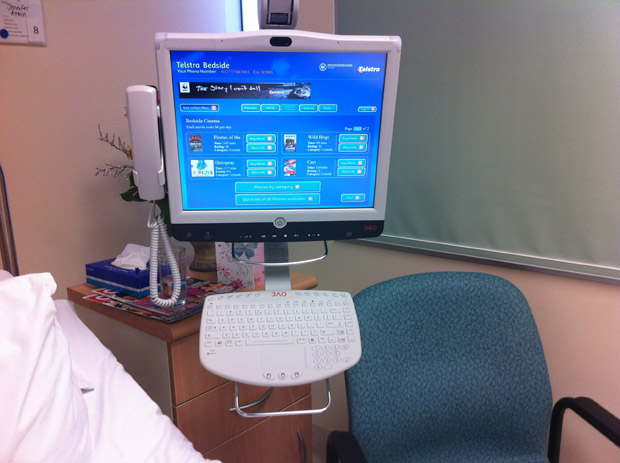SA Health taps Telstra for bedside roll-out

Telstra will install 3500 new tablet computers into South Australian hospitals over the next 12 months, in a deal with the SA Government worth up to $36.7 million.

(Credit: Telstra)
Telstra will roll out the 25.4cm touchscreens into eight metropolitan and four regional hospitals over the next year, following a proof-of-concept trial at the Lyell McEwin Hospital in 2006 of 100 beds with 12,000 patients. Telstra won the eight-year tender for the integrator role last year.
The "Telstra Bedside" computers operate primarily for patient care, embedded with Windows 7, with clinicians able to enter a smart card into the computer as well as an individual PIN to authenticate their identity. Through a thin client application, the clinician then connects back to the SA Health clinical application services. This connects back to patient records through Telstra's Next IP network to SA Health's datacentres, and will allow clinicians to complete tasks such as ordering medication or tests.
In addition to medical services, the devices can be used to make voice calls, as well as be an entertainment unit, with free-to-air, pay TV and filtered internet access available for patients for a fee of between $6 and $18 a day.
Although iPads are popular in both consumer and business, and was being considered in health by the former Victorian government, Chris Pearce, Telstra's executive director for government and not-for-profit, told ZDNet Australia that the 25.4cm devices were the best pick for a hospital environment.
"Because it is a touchscreen, you will want something that is a reasonable size. The keyboard and the screen is all disinfectable [sic]. So you can disinfect it," he said.
It was also important for the screen to be decently sized for patients and doctors to be able to view patient data such as x-rays, he added.
Pearce said that the combination of both medical assistance and entertainment will make a patient's life much better in hospital.
"To have movies on demand, to be able to surf the web, Foxtel and digital radio is just fantastic," he said.
Although Telstra was focused on this roll out for now, Pearce said that the system may have wider applications, such as making it mobile on Telstra's Next G or 4G networks.
"This solution has a number of different applications. I think the prospect of a total mobile solution is something we would be most likely to have a look at," he said, saying that Telstra would look at other applications it could add to the system, too.
"One of the areas where it is going to be broadened over time is as a patient, you will be able to order food. You will be able to do that online. And one of the great things, is that if you're allergic to a particular food then you won't be able to order it. It will all actually be programmed into the system."
SA Health Minister John Hill said the roll-out is unique to Australia.
"South Australia is the first state in the country, and one of the first places in the world, to put electronic clinical applications at patients' bedsides on this scale," he said in a statement.
"The computers will provide a clinical workstation for doctors and nurses, and help standardise and improve clinical work practices across the whole health system."
The roll-out will begin at Noarlunga Hospital at the end of this month and will also be rolled out to the following hospitals over the next year:
- Lyell McEwin Hospital
- Royal Adelaide Hospital
- Modbury Hospital
- Flinders Medical Centre
- The Queen Elizabeth Hospital
- Repatriation General Hospital
- Women's and Children's Hospital
- Port Augusta Hospital
- Port Pirie Hospital
- Whyalla Hospital
- Mount Gambier Hospital.